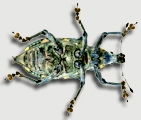Linnen CR, Farrell BD.
Phylogenetic analysis of nuclear and mitochondrial genes reveals evolutionary relationships and mitochondrial introgression in the sertifer species group of the genus Neodiprion (Hymenoptera : Diprionidae). Molecular Phylogenetics and Evolution. 2008;48 (1) :240-257.
DOI (full text)AbstractNeodiprion Rohwer (Hymenoptera: Diprionidae) is a Holarctic genus of conifer-feeding sawflies with a remarkable amount of inter- and intraspecific diversity in host use, behavior, and development. This variation is thought to play a central role in Neodiprion diversification, but speciation hypotheses remain untested due to a lack of a robust phylogenetic estimate. Here, we utilize sequence data from three nuclear genes (CAD, ANL43, EF1 alpha) to obtain a phylogenetic estimate for the genus. These analyses suggest that: (1) North American and Eurasian Neodiprion are monophyletic sister clades, (2) the sertifer group is paraphyletic with respect to the monophyletic lecontei group, and (3) on at least two occasions, dispersal from eastern to western North America proceeded via southern host bridges. Based on these results and host biogeography, we revise a previous scenario for the evolution of Neodiprion and suggest maximum ages for the genus and for the lecontei group (25 My and 14 My, respectively). In addition, because a previous study reported rampant mitochondrial introgression in the lecontei group, we assess its prevalence in the sertifer group. Analysis of three mitochondrial genes (COI, tRNA-leucine, and COII) reveals that mito-nuclear discordance is prevalent in the sertifer group, and patterns of species monophyly are consistent with those expected under frequent mitochondrial introgression. As was the case for lecontei group species, we find that introgression appears to be most pronounced between species that occasionally share hosts, suggesting that divergent host use is an important barrier to gene flow in Neodiprion. Finally, we suggest that the lack of phylogenetic resolution and prevalence of species non-monophyly in the non-Pinus feeding Neodiprion may result from the rapid divergence (possibly with gene flow) of these species following their entry into a novel adaptive zone. (C) 2008 Elsevier Inc. All rights reserved.
Linnen CR, Farrell BD.
Comparison of Methods for Species-Tree Inference in the Sawfly Genus Neodiprion (Hymenoptera: Diprionidae). Systematic Biology. 2008;57 (6) :876-890.
DOI (full text)AbstractConifer-feeding sawflies in the genus Neodiprion provide an excellent opportunity to investigate the origin and maintenance of barriers to reproduction, but obtaining a phylogenetic estimate for comparative studies of Neodiprion speciation has proved difficult. Specifically, nonmonophyly within and discordance between individual gene trees, both of which are common in groups that diverged recently and/or rapidly, make it impossible to infer a species tree using methods that are designed to estimate gene trees. Therefore, in this study, we estimate relationships between members of the lecontei species group using four approaches that are intended to estimate species, not gene, trees: (1) minimize deep coalescences (MDC), (2) shallowest divergences (SD), (3) Bayesian estimation of species trees (BEST), and (4) a novel approach that combines concatenation with monophyly constraints (CMC). Multiple populations are sampled for most species and all four methods incorporate this intraspecific variation into estimates of interspecific relationships. We investigate the sensitivity of each method to taxonomic sampling, and, for the BEST method, we assess the impact of prior choice on species-tree inference. We also compare species-tree estimates to one another and to a morphologically based hypothesis to identify clades that are supported by multiple analyses and lines of evidence. We find that both taxonomic sampling and method choice impact species-tree estimates and that, for these data, the BEST method is strongly influenced by and branch-length priors. We also find that the CMC method is the least sensitive to taxonomic sampling. Finally, although interspecific genetic variation is low due to the recent divergence of the lecontei group, our results to date suggest that incomplete lineage sorting and interspecific gene flow are the main factors complicating species-tree inference in Neodiprion. Based on these analyses, we propose a phylogenetic hypothesis for the lecontei group. Finally, our results suggest that, even for very challenging groups like Neodiprion, an underlying species-tree signal can be extracted from multi-locus data as long as intraspecific variation is adequately sampled and methods that focus on the estimation of species trees are used.
